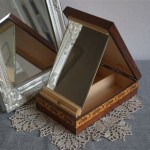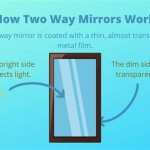How to Make an Anti-Fog Mirror
Foggy mirrors are a common nuisance, particularly after a hot shower or bath. This condensation occurs when warm, moist air comes into contact with a cooler surface, like the mirror. Preventing this fogging requires either warming the mirror surface to match the ambient air temperature or creating a barrier that repels the water molecules. Several methods can achieve these effects, offering varying degrees of effectiveness and longevity.
One effective method is applying a commercial anti-fog spray. These sprays typically contain surfactants that reduce the surface tension of the water, causing it to sheet across the mirror rather than beading up and obscuring the reflection. Application is straightforward; simply spray the product onto a clean mirror and wipe it evenly with a soft cloth. Reapplication may be necessary every few days or after heavy use.
Another convenient solution involves using anti-fog wipes. Similar in principle to the sprays, these pre-moistened wipes offer portability and ease of application. They are ideal for travel or gym use and often come individually packaged for hygienic application. The effectiveness duration varies depending on the product and environment, but typically lasts for a few days.
For a more long-term solution, consider installing a heated mirror pad. These pads adhere to the back of the mirror and gently warm the glass, preventing condensation from forming. They require an electrical connection and are often installed during bathroom renovations or new construction. Heated mirror pads provide consistent fog-free performance, eliminating the need for continuous reapplication of sprays or wipes.
A DIY approach to preventing fog involves using shaving cream. A thin layer of shaving cream applied to the mirror and then wiped clean can leave a residue that repels water for a short period. While not as effective or long-lasting as commercial products or heated pads, it offers a quick and readily available solution.
Glycerin, commonly found in soap and personal care products, can also create a temporary anti-fog effect. Mix a small amount of glycerin with water and apply it to the mirror with a soft cloth. The glycerin creates a thin, transparent film that inhibits condensation. However, this method requires frequent reapplication, typically after each shower or bath.
Another DIY method uses a mixture of vinegar and water. Mix equal parts white vinegar and water in a spray bottle and apply it to the mirror, wiping it clean with a cloth. The acidic nature of the vinegar can help break down the surface tension of water, similar to commercial anti-fog sprays, but the effectiveness can be less consistent and may require more frequent application.
A more preventative measure involves improving bathroom ventilation. Adequate ventilation helps remove excess moisture from the air, reducing the likelihood of condensation on the mirror. Running an exhaust fan during and after showering or bathing can significantly reduce mirror fogging. Opening a window can also help, especially in smaller bathrooms.
Choosing the right method depends on individual needs and preferences. For quick and temporary solutions, shaving cream, glycerin, or the vinegar/water mixture can be effective. For more long-lasting results, commercial anti-fog sprays, wipes, or heated mirror pads offer greater convenience and reliability. Improving bathroom ventilation provides a more preventative approach, minimizing moisture buildup and reducing the need for other anti-fog methods.
Regardless of the chosen method, proper mirror cleaning is essential for optimal results. Regularly cleaning the mirror with a glass cleaner removes soap scum, toothpaste residue, and other buildup that can interfere with the effectiveness of anti-fog treatments. A clean mirror surface provides a better base for anti-fog solutions to adhere to and function effectively.
When using commercial products, always follow the manufacturer's instructions. Some products may require specific application techniques or precautions. Additionally, it is important to test any DIY solution in an inconspicuous area first to ensure compatibility with the mirror surface and avoid potential damage.
By understanding the principles of condensation and exploring the various methods available, individuals can effectively combat the frustrating problem of foggy mirrors and enjoy clear reflections regardless of bathroom humidity.

How To Stop Your Mirror From Fogging Up Home Repair Tutor

Tips To Prevent Your Bathroom Mirror From Steaming Up

Three Easy Ways To Stop Your Bathroom Mirror From Fogging Up

One A Day To Keep Foggy Mirrors At Bay Anti Fog Nofogg

5 Simple Ways To Keep Your Bathroom Mirror From Fogging Up Housekeeping Wonderhowto

Antifog Mirrors Want To See Yourself In Pristine Clarity Every Day

Anti Fog Bathroom Led Mirror Wall Mounted With Light Make Up For Bendroom Multiple Size Com

Tycolit 40 In 1 Light Black Led Vanity Lights Bathroom Mirror With Anti Fog Memory And Dimmable Touch Sensor Horizontal Yb W70832307 The Home Depot

Omem Led Wall Mounted Mirrors Bathroom Mirror Horizontal Vertical Mak Omem1

Ktaxon 40 X24 Led Dimmable Bathroom Mirror Lighted Wall Mounted For Vanity With Touch On And Anti Fog Function Horizontal Vertiacl Com








